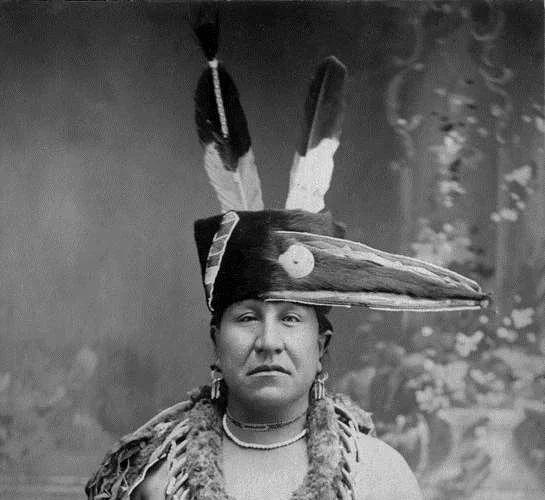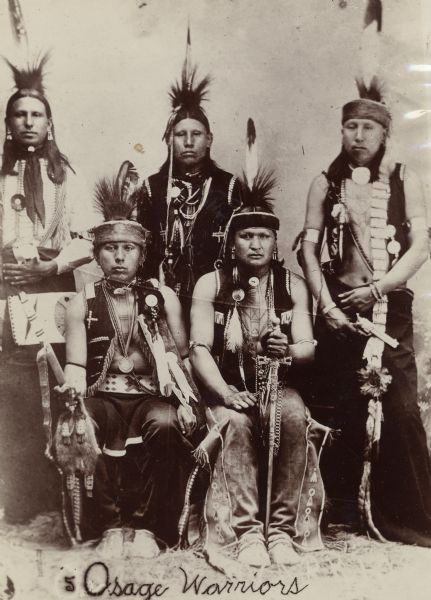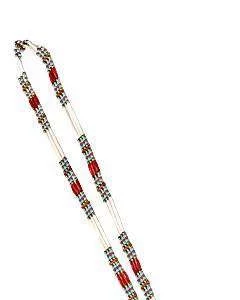There are many old photographs of certain Omaha-Ponca Hethuska or Osage Inlonshka members wearing a turban of otter fur, or a turban of red fox fur.
Dr. James Howard states,
“The otterskin hat, rather than the war bonnet, was the ‘chief’s’ headdress, while a similar headdress of fox fur marked the experienced warrior.”
(Howard, 1965, p. 66)
While in “The Omaha Tribe,” Fletcher and LaFlesche states,
“The peculiar headgear shown in plates 36 and 49 (otter fur turbans), was worn only by chiefs; it bore the name watha’ge, which was applied to all caps which fit the head.”
(Fletcher & LaFlesche, 1911, p. 354)
The red fox fur turban was usually narrow and plain, giving the appearance of a large headband and were sometimes worn in combination to the hair roach. Sometimes these small turbans were also made from otter fur as well, depending on the tribe.
In contrast, the highly decorated otter fur turbans however,
“…was a wide band of otter fur which encircled the head like a crown. The top was left open, and if a warrior wished he could place an eagle feather in his scalplock and let it stick up through the cap. The tail of the otter was attached to the rear of the cap in such a way as to hang down the warrior’s back. Sometimes the edges of the cap and tail were beaded, and a tuft of dyed horsehair was appended to the end of the tail. Four round beaded targets were also attached to the wide band of the cap for decoration.”“While some of the southern tribes wore a slight variation of the cap just described, the hat most unique to the southeast had a huge hide triangle, with beaded or painted (or ribbon appliqué) symbols on it, which extended out to the left or right side of the wide headband.”…“Such hats were worn by the Pawnee, Ponca, Osage and Oto warriors.”
(Mails, 1972, pp. 385-387)
As already stated, the otter fur turbans were worn only by the Ponca chiefs or sub-chiefs and,
“…a chief wore a downy eagle plume erect in a socket at the back of his otterskin hat.”
(Howard, 1965, p. 66)
Today, fur turbans are seldom seen among the Ponca Hethuska or the Osage Inlonshka members, though they seem to becoming more popular at pow-wows.
According to an article written by Norman Feder titled “Otter Fur Turbans,” and published in a 1960 issue of American Indian Tradition, other tribes besides the Ponca and Osage had otter fur turbans including the Sauk & Fox, Iowa, Otoe, Missouri, Kaw, Pawnee, Omaha, Comanche, Kiowa, Menomini, Potowatomi and Quapaw. (Feder, 1960, p. 4)
In addition, I have seen otter fur turbans used among some Southern Cheyenne, and Oklahoma Delaware as well.
Lastly, in reference to otter fur turbans, Alanson Skinner states,
“…the most valued variety is a fillet of dark otter fur. Not only does it present a handsome appearance, but the connection of the otter with the sacred rites and origin myth of the Medicine Dance society and it’s own supposed supernatural powers…”
(Skinner, 1921, p. 109)
It should be noted, that many tribes still follow traditions which are said to have certain guidelines associated with who is given the right to wear an otter fur turban, and what titles and obligations wearing one implies.
Some examples from the past:
Kiowa
Ho Chunk
Man Chief – Pawnee – 1858
The Chief Whom They Look Upon – Pawnee – no date
Eagle Chief – Pawnee – 1905
Post Oak Jim (on right), and his brother – Comanche – 1895
Sitting In The Saddle – Kiowa – 1867
Sitting In The Saddle – Kiowa – no date
Lone Chief, Standing Buffalo Bull, Iron Whip, Walks With Effort I – Ponca – 1858
Black Crow – Ponca – 1877
Standing Bear – Ponca – 1881
True Eagle – Otoe – 1868
Medicine Horse – Otoe – 1869
Standing Eating – Otoe – 1884
Far Away – Otoe – 1884
Makes A Noise – Otoe – 1884
White Horse – Otoe – 1895
James Arkeketah – Otoe – no date
John Pipestem, Albert Green – Otoe – 1906
Red Bear – Otoe – 1908
Black Hawk – Iowa – 1869
Nag-A-Rash – Iowa – 1869
Buffalo Chief – Iowa – 1869
Pa-de-gi-he – Omaha – no date
The Chief – Omaha – no date
The Chief – Omaha – 1869
White Swan – Omaha – 1883
Yellow Smoke – Omaha – 1883
Standing Bear, (wife and daughter on left), Yellow Smoke, (wife and daughter on right) – Omaha – 1883
Omaha man – 1902
Omaha man – 1902
Omaha men – 1907
Standing Bear – Omaha – 1909
Bear In The Fork Of A Tree – Sauk & Fox – 1858
Sauk & Fox men – 1866
Po-Ga-Ha-Ma-We – Sauk & Fox – 1888
Po-Ga-Ha-Ma-We – Sauk & Fox – 1888
Cannot Do It – Sauk & Fox – 1890
Cannot Do It – Sauk & Fox – 1890
Nish-ke-kot with son and daughter – Sauk & Fox – 1895
Hard Thinker – Sauk & Fox – 1896
Wam-Pash-Ka – Sauk & Fox – 1896
Picking Up Something – Sauk & Fox – 1896
Po-Ga-Ha-Ma-We – Sauk & Fox – 1896
Po-Ga-Ha-Ma-We – Sauk & Fox – 1896
Po-Ga-Ha-Ma-We – Sauk & Fox – 1896
Fish Rub Against Something – Sauk & Fox – 1896
Fish Rub Against Something – Sauk & Fox – 1896
Fish Rub Against Something – Sauk & Fox – 1896
Fish Rub Against Something – Sauk & Fox – 1896
Na-wat-ena, Po-ga-ha-ma-we, and Pi-pi-qua – Sauk & Fox – 1896
Old Eye – Sauk & Fox – no date
Pa-thin-non-pa-zhi – Osage – 1868
Non-pe-wa-the – Osage – 1868
Osage men – 1868
Reaches The Sky – Osage – 1877
Henry Red Eagle and son – Osage – 1893
Osage men – no date
Osage men – no date
Osage men – no date
Playful Chief – Osage – 1900
Bacon Rind – Osage – 1900
Man Of Courage, Black Dog – Osage – 1904
Bone Heart – Osage – 1906
Red Eagle – Osage – 1908
Comes Upon The Village – Osage – 1908
Playful Sun Carrier – Osage – 1908
Generous – Osage – 1911
Bacon Rind – Osage – 1916
Feder, Norman.
1960. [U]Otter Fur Turbans[/U]. American Indian Tradition Newsletter, Vol. 7.
Fletcher, Alice C. and Francis LaFlesche.
1911. [U]The Omaha Tribe[/U]. Bureau of American Ethnology, 27th Annual Report 1905-06, Smithsonian Institution, U.S. Government Printing Office, Washington, D.C.
Howard, Dr. James H.
1965. [U]The Ponca Tribe[/U]. Bureau of American Ethnology, Bulletin 195, Smithsonian Institution, U.S. Government Printing Office, Washington, D.C.
Mails, Thomas E.
1972. [U]The Mystic Warriors of the Plains[/U]. Garden City, New York: Doubleday.
Meadows, William.
1999. [U]Kiowa, Apache and Comanche Military Societies[/U]. University of Texas Press, Austin, TX.
Murie, James R.
1914. [U]Pawnee Indian Societies[/U]. Anthropological Papers, American Museum of Natural History, Vol. 11, No. 7, New York, NY.
Skinner, Alanson B.
1915-a. [U]Societies of the Iowa, Kansa and Ponca Indians[/U]. Anthropological Papers, American Museum of Natural History, Vol. 11, Part 9, New York, NY.
1915-b. [U]Kansa Organizations[/U]. Anthropological Papers, American Museum of Natural History, Vol. 11, New York, NY.
1915-c. [U]Ponca Societies and Dances[/U]. Anthropological Papers, American Museum of Natural History, Vol. 11, New York, NY.
1921. [U]Material Culture of the Menomini[/U]. Indian Notes and Monographs, No. 20, Museum of American Indian, Heye Foundation, NY.
Last Updated on August 14, 2016 by Paul G










































































